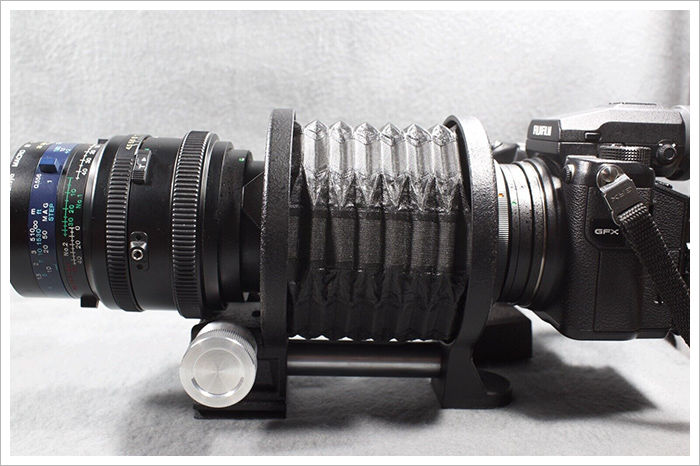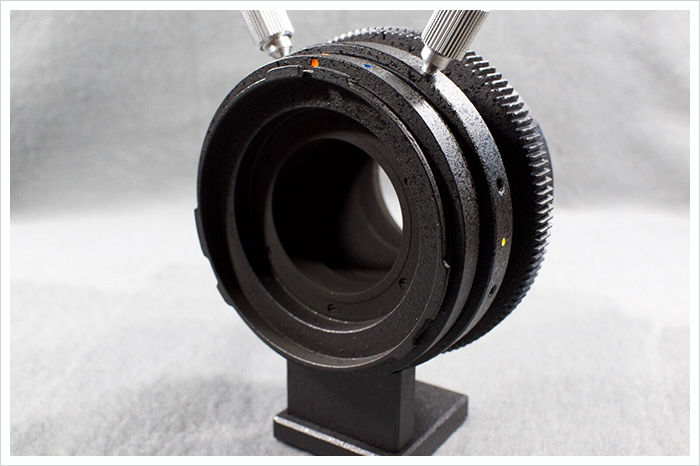So, I am in conversation with a guy in Germany, who is i believe, a representer of Ukrainian Hartblei adapters. The cheapest adapter at around 390 € for Mamiya RZ67 lenses, has a bellow. But as i suspected you can only mount the camera horizontally.
With a little special screwdriver, you can change the position of the mount, so that it goes into a vertical position. Which isn't bad, to begin with. I mean, better than having an adapter where the camera is always position horizontally. But it might be fiddly, I assume.
Or - you can add a 50€ special vertical portrait adapter to the setup. Also here you have to detach the camera, take off the current adapter ring, and replace it with a portrait adapter, so the camera stays in vertical position.
Still fiddly.


Then there is the RBZ adapter
which costs 590 € + shipping. This one includes the rotational mount which means - position the camera between vertical and horizontal alignment. (No shift, nor tilt)
However, the extension is less then that of the bellows. That means you will not be able to do macro or closer close-ups. Where the boundaries go, I do not know. (I am trying to get answers for that)
My last question was, how much that adapter actually extends. Also, perhaps even more important; how much must the adapter extend in order to achieve infinity, to begin with. [not much at all]. Then - the second question was - how much of extension is left to focus the Mamiya Sekor Z lens closer ?
Result
when adapting a Mamiya APO Sekor Z 210mm ƒ4.5 lens - which already has a longer min focus distance compared to similar focal lengths - you can focus down to only 3 meter. With the Mamiya RZ extension ring No 1, you get 1.2 meter. That's in the rage of what I like [close up -ish], and don't need more. I still have the Pentax 67 system for that if needed to go really close.
He was willing to offer me free shipping - which at least makes the adapter a tiny notch cheaper.
But - it is already at price point where I start to get sensitive, when calculated into Swedish Krona, ending up around around 6700 SEK.



Sturdy !
But the setup is - or seems - far more straight and sturdy, compared to the bellow adapter which requires you to take away the camera mount adapter - and then in its place mount a vertical portrait adapter to it - so you can take vertical images.
I am inclined to the last adapter even if it is more expensive.
Why adapting Mamiya RZ67 lenses ?
To be honest; it would be fun to adapt to the Mamiya RZ 67 lenses to the Fujifilm GFX camera system. Just to be ABLE to use them, is rather rare and cool in itself. They are perhaps the least adaptable friendly lenses of all medium format lenses in the world. So, "doomed to be only used with film". Yet, also one of the most affordable of all medium format lenses, too.
Why not using them - as I have them at home since 1988 ! The system has grown significantly since the 2010s:
• Mamiya Sekor Z 37mm Fisheye ƒ 4.5
•
50mm ƒ 4.5
•
65mm ƒ 3.5
•
75mm Shift ƒ 4.5
•
90mm ƒ 3.5
•
110mm ƒ 2.8
•
150mm ƒ 3.5
•
180mm ƒ 4.5
•
APO 210mm ƒ 4.5
•
250mm ƒ 4.5
•
360mm ƒ 6.0
•
100-200mm zoom / 5.2
•
the 1.4x extender which can be used with most lenses.
Not all of them makes sense to adapt
on the Fujifilm GFX system. I would assume that the 90mm, 110mm, 150mm, and 210mm could provide interesting focal lengths with the Fujifilm GFX camera. In the studio it would be between 90 - 210 mm, since they get "longer" on the Fujifilm GFX due to the crop factor.
The crop factor is around 1.7x i have read at dPreview (if compared to the 6x7 format !)
But in truth, a 110 mm lens is still 110 mm in its origin when you adapt it to the GFX. It acts then like a very slight telephoto lens - as if you would use a 85 mm lens on fullframe. So, a Mamiya RZ67 Sekor Z 210 mm lens, acts like a 165 mm portrait lens on the Fujifilm GFX camera.
Even if the adapter only uses the center portion of the lens due to the smaller GFX sensor compared to the 6x7 negative format - I would still be fun. To transfer these lenses into the realm of digital photography, so to speak.
"I have heard" that they don't perform that well when used wide open. It is when you stop them down, they perform very well. On the other hand, the guy from eBay said that the latest version of the Mamiya Sekor Z Macro 140mm ƒ4.5 lens is a stunning performer. I believe that most of them are stunning,once you stop them down 2-3 stops. Which is the case with almost all medium format lenses. They have been made that way, to be stopped down 2-3 stops.
Well, will see about that in the relatively near future, likely somewhere mid January 2025. |

